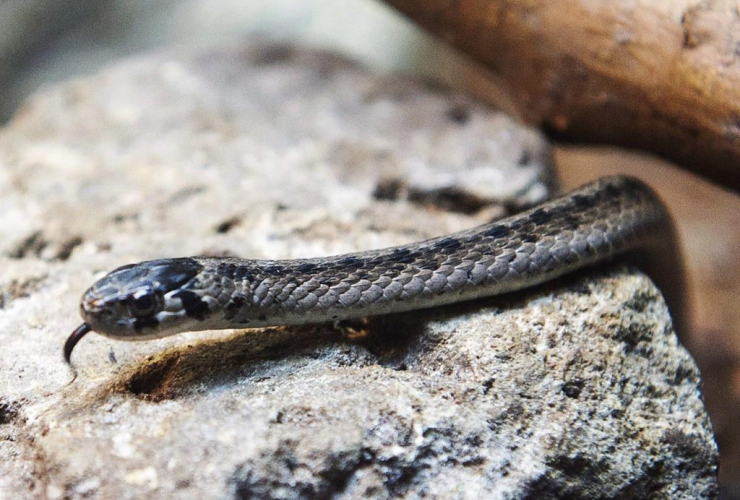One rattlesnake got caught in freshly laid tar under someone's stairs.
Others typically get twisted and trapped in garden netting.
Ryan Heavy Head comes to the rescue of both the vipers and the terrified homeowners.
"I call myself a rattlesnake wrangler," says the 47-year-old, who runs a rattlesnake mitigation program in Lethbridge, southeast of Calgary.
He's also on call with the program's rattlesnake hotline, which runs April to October.
The line gets anywhere from 60 to 170 calls a year, and the number has been rising along with new housing developments on bluffs above the city's river valley.
Heavy Head estimates there are about 600 rattlers living along the deep ravines and coulees of the Oldman River.
A deserted area that was once a dump with half-buried slabs of concrete has become a rookery where female snakes gather before they give birth.
"It's just like snake heaven," says Heavy Head as he carefully walks through the area. He's wearing open-toed sandals, a short-sleeved T-shirt, camouflage shorts and a hat.
Without hesitation, he approaches one snake with a short stick and lifts it up off the ground. The distinctive sound of its shaking tail doesn't phase him.
"I've got to be careful because I'm still within the strike range and if she were to pull back — she's coiled tight enough — she could lunge her body at me," he says.
Heavy Head manages to get the snake into a long, clear plastic tube so he can get a closer look.
"She's got golden eyes. You see those eyes? They're dragon eyes," he says admiringly.
Heavy Head, originally from Oregon, says he loves snakes. He got his first pet snake, a boa constrictor, when he was eight.
After a stint in the United States army and completing a degree in cultural anthropology, he took over the Lethbridge rattlesnake program.
One recent hotline call came from the University of Lethbridge, where some small rattlers had worked their way through the vents and into a maintenance room.
Heavy Head put them in a dark case made out of strong plastic that attached to his backback. He then returned them to a den in the area.
Dogs are most at risk of being bitten. Rattlesnake bites in humans are rarely fatal, he says.
He recalls how one woman learned the hard way how quickly a snake reacts. She was in her yard with her husband, who was using a lawn trimmer. Because the machine was so loud, she didn't hear the warning rattle of a nearby snake.
"She reached under a bush and put her hand right on the snake and it bit her," he says. "By the time she travelled to hospital she said her hand was like a lobster claw."
Heavy Head says the size of the snake doesn't matter.
"They've got the same venom, so it still hurts."
So far, he hasn't been pierced with rattlesnake fangs.
"But I am going to get bit eventually."




Comments